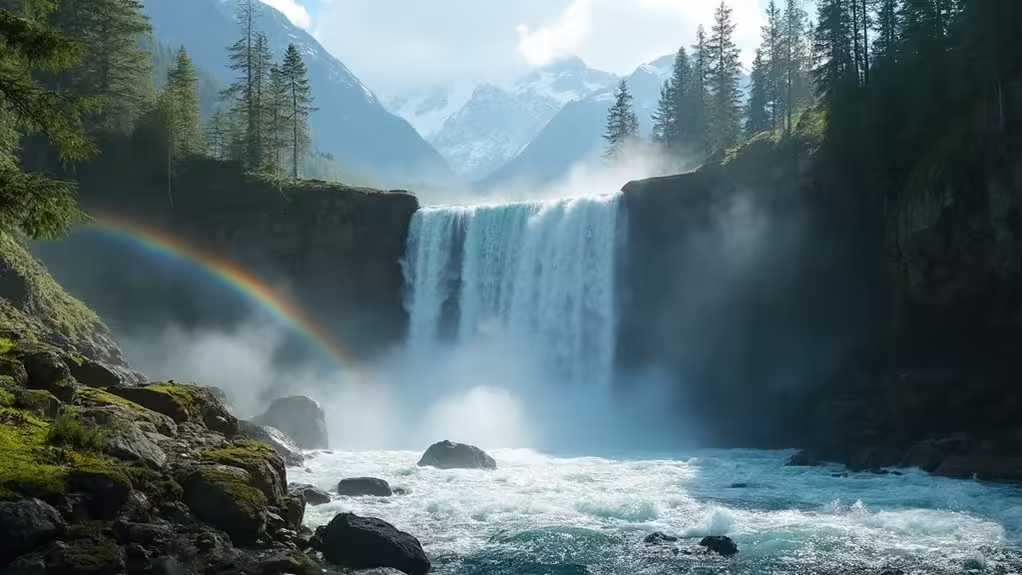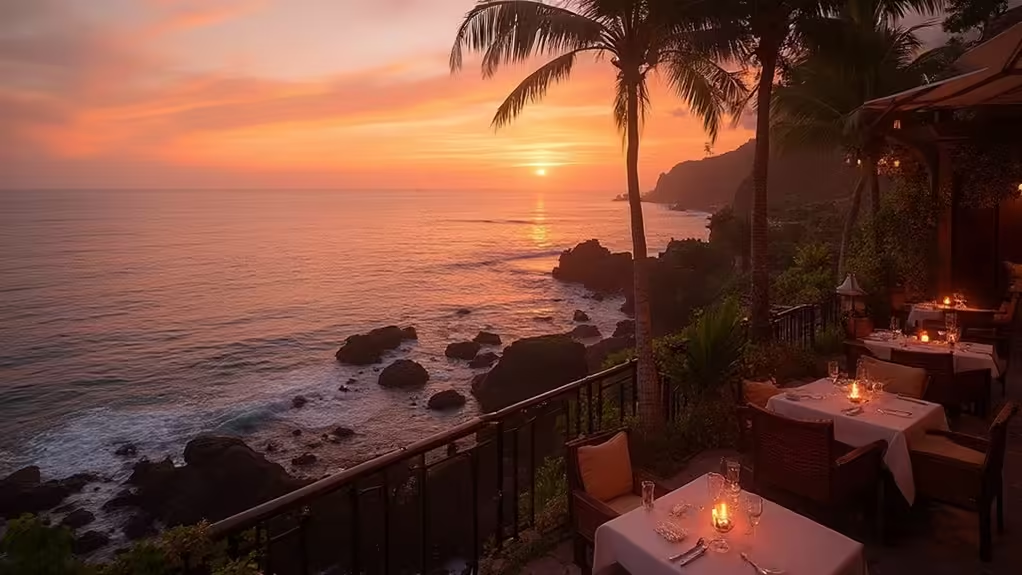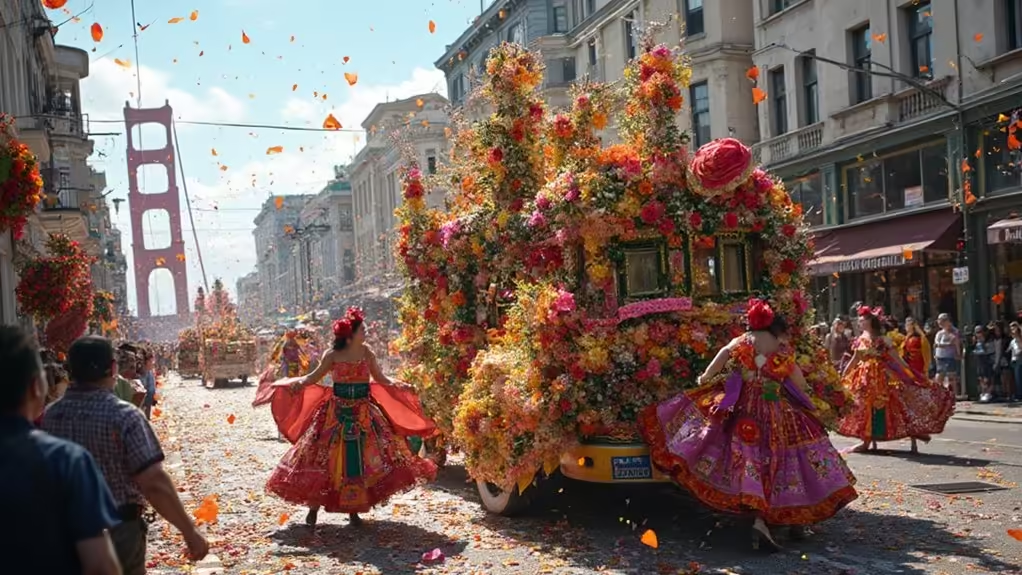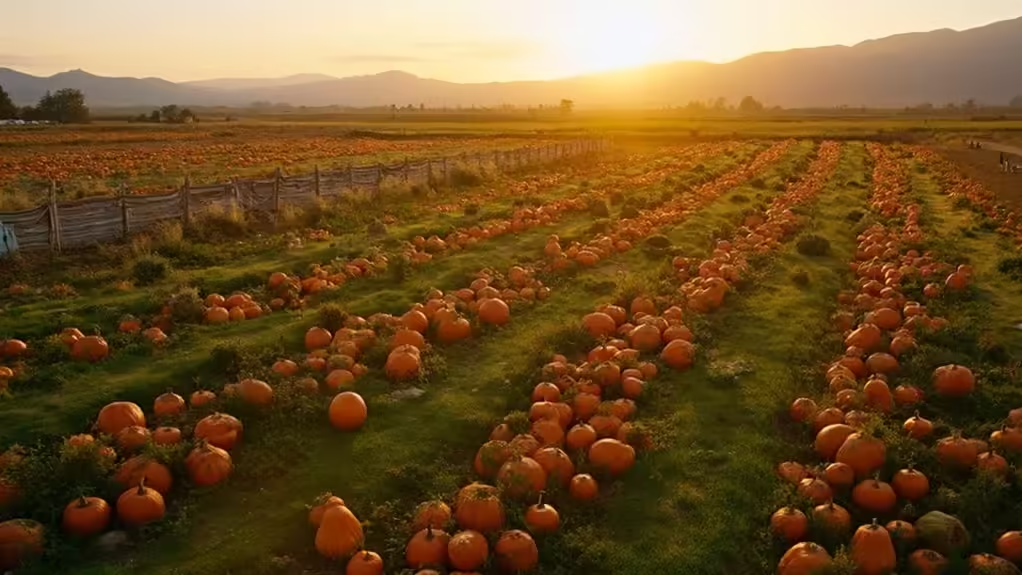The West Coast's most powerful seasonal waterfalls are a breathtaking sight to behold. You'll find iconic cascades like Yosemite Falls, North America's tallest at 2,500 feet, and the misty Bridalveil Fall nearby. In Big Sur, McWay Falls uniquely plunges onto a beach, while Alamere Falls in Point Reyes drops directly into the ocean. The Pacific Northwest boasts thundering Snoqualmie Falls, perfect for photography. Peak flow occurs from April to June in California, and late fall to early spring in the Northwest. Hiking trails like the Mist Trail in Yosemite offer up-close views of these natural wonders. For the adventurous, hidden gems await revelation in the region's lush forests and rugged coastlines.
Table of Contents
ToggleLearn More
- Yosemite Falls, North America's tallest waterfall at 2,500 feet, reaches peak flow from April to June.
- Snoqualmie Falls offers year-round 270-foot thundering cascades, ideal for photography and easily accessible.
- McWay Falls in Big Sur uniquely cascades directly onto a beach, viewable from an overlook on Highway 1.
- Alamere Falls, a rare tidefall in Point Reyes, flows year-round and drops 40 feet into the ocean.
- Pacific Northwest waterfalls, like those in Olympic National Park, are most powerful from late fall to early spring.
Iconic Cascades of the West
From the misty heights of Yosemite to the rugged coasts of the Pacific Northwest, the West Coast is home to some of North America's most awe-inspiring waterfalls. You'll find yourself enthralled by the sheer power and beauty of these natural wonders, each offering a unique experience for journey seekers and nature lovers alike.
Yosemite Falls reigns supreme as the tallest waterfall in North America, plunging nearly 2,500 feet in a spectacular display of nature's force. Not far away, Bridalveil Fall creates a mesmerizing veil of mist, easily accessible for those eager to feel its spray. If you're looking for a truly unique sight, head to Big Sur's McWay Falls, where water cascades directly onto a pristine beach.
For a more rugged experience, venture to Alamere Falls in Point Reyes National Seashore. This rare tidefall flows year-round, dropping 40 feet into the ocean. And don't miss Snoqualmie Falls in Washington, where you can witness 270 feet of thundering water, perfect for capturing breathtaking photos. These iconic cascades offer freedom to journey and connect with nature's raw power.
Peak Flow Seasons
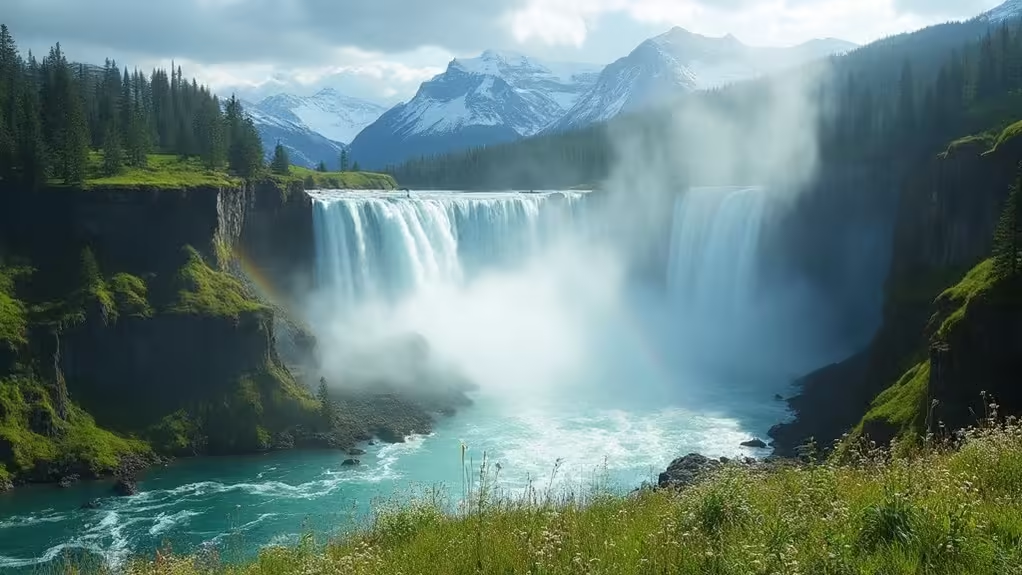
Timing is everything when it comes to witnessing the West Coast's waterfalls at their most spectacular. If you're seeking the ultimate waterfall experience, you'll want to plan your visit during peak flow seasons. In California, you'll find the most awe-inspiring displays between April and June, when snowmelt dramatically increases water volume. Iconic falls like Yosemite and Bridalveil reach their pinnacle during this time, offering a breathtaking show of nature's power.
For those venturing into the Pacific Northwest, late fall through early spring is your best bet. The region's rainy season converts cascades like Multnomah and Snoqualmie into thundering spectacles. Don't wait until summer, though – many seasonal waterfalls can dry up as the weather warms.
If you're after year-round action, coastal tidefalls such as Alamere Falls are your ticket to freedom. These unique cascades maintain flow throughout the seasons, but winter and early spring pack the biggest punch after heavy rains. Remember, the West Coast's most powerful waterfalls are waiting for you – all you need to do is time your visit right!
Hiking Trails to Thundering Waters
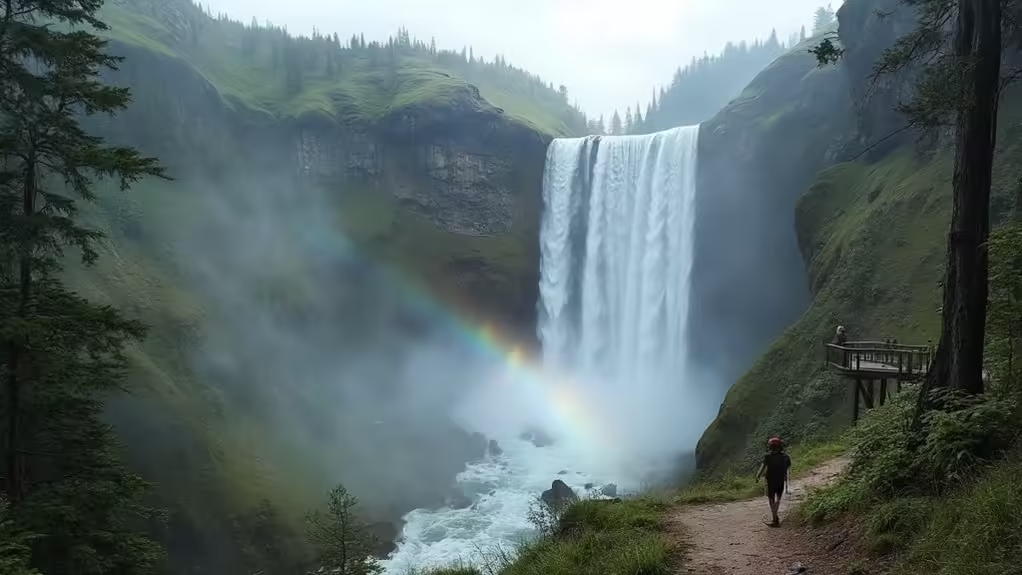
A expedition to witness the West Coast's thundering waters wouldn't be complete without hitting the trails. You'll find some of the most spectacular waterfalls in California along the Mist Trail in Yosemite, which is renowned for its awe-inspiring views. This challenging 5.4-mile hike leads you to Vernal and Nevada Falls, where you'll be rewarded with breathtaking views of seasonal cascades and the most beautiful hiking trails in California. As you ascend the granite steps and traverse the misty path, you’ll be enveloped by the sound of rushing water and the sight of rainbows dancing in the mist. The area is not only home to these iconic waterfalls, but also offers picturesque views of Yosemite’s vibrant fall hues, making it one of the top California fall foliage destinations. Whether you visit in spring for the powerful gush of waterfalls or in autumn for the stunning foliage, the Mist Trail promises an unforgettable adventure year-round.
For a shorter hike, head to Kings Canyon National Park. The Roaring River Falls trail offers a 1.5-mile excursion to one of the park's most powerful waterfalls. In Sequoia, you can't miss the Tokopah Falls trail, a 4-mile trek to a stunning 1,200-foot waterfall that's especially impressive in spring.
If you're near Ramona, don't skip the Cedar Creek Falls hike. This 6.6-mile trail leads to an 80-90 foot waterfall that's at its most magnificent in winter. For the ultimate waterfall experience, venture to Oregon's Silver Falls loop trail. You'll encounter ten waterfalls, including the jaw-dropping 177-foot South Falls. These hiking trails offer freedom-seekers the perfect opportunity to connect with nature and witness the raw power of cascading waters.
Photography Tips for Waterfall Enthusiasts

You'll want to perfect a few key techniques to capture stunning waterfall photos. Start by adjusting your camera settings, focusing on shutter speed and aperture to achieve the desired effect. Next, consider your composition, using natural elements to frame the waterfall and create depth in your images. Don't forget to take advantage of seasonal lighting changes, as they can dramatically alter the mood and appearance of your waterfall shots.
Ideal Camera Settings
Capturing the ethereal beauty of West Coast waterfalls requires mastering the right camera configurations. You'll want to start by setting your shutter speed between 1/4 and 2 seconds for that silky smooth water effect, especially during spring's peak runoff. Next, dial in your aperture between f/8 and f/16 to keep everything sharp from foreground to background.
Don't forget your tripod! It's essential for those long exposure shots, keeping your camera steady in the often dim, forested areas around waterfalls. As you frame your shot, experiment with different angles and compositions. Try including rocks or foliage in the foreground to add depth and interest to your images.
Keep an eye on your camera's histogram to avoid blown-out highlights, and consider using a polarizing filter to cut glare and enhance colors. Remember, the key to stunning waterfall photos is practice and patience. Don't be afraid to get your feet wet (literally) as you search for the perfect vantage point. With these settings and techniques, you'll be capturing breathtaking images of the West Coast's most powerful seasonal waterfalls in no time.
Composition Techniques
Mastering composition techniques is essential for capturing stunning waterfall photographs. When framing your shot, remember the rule of thirds. Place the waterfall off-center to create a vibrant composition that draws the viewer's eye through the scene. This approach adds visual interest and makes your images more engaging.
Don't forget to incorporate foreground elements like rocks or plants. These add depth and setting to your waterfall photography, making the image feel more immersive. You'll transport viewers right into the scene, allowing them to almost feel the spray of the water.
To enhance your shots, consider these tips:
- Experiment with various shutter speeds
- Shoot during the golden hours for softer light
- Use a tripod for longer exposure times
Seasonal Lighting Considerations
Seasonal changes dramatically impact lighting conditions for waterfall photography, offering unique opportunities throughout the year. As you plan your West Coast waterfall excursions, keep in mind that early morning and late afternoon provide the best soft lighting, enhancing colors and reducing harsh shadows. Don't shy away from overcast days, as they can be a blessing in disguise. The diffuse light minimizes glare on water surfaces and brings out details in the surrounding scenery.
To capture the essence of these powerful falls, you'll want to experiment with longer exposure times. Use a tripod to achieve that silky smooth effect on the water flow, emphasizing the motion of the falls. If you're shooting in brighter conditions, consider using a neutral density filter to allow for longer exposures.
Safety Precautions for Waterfall Visits
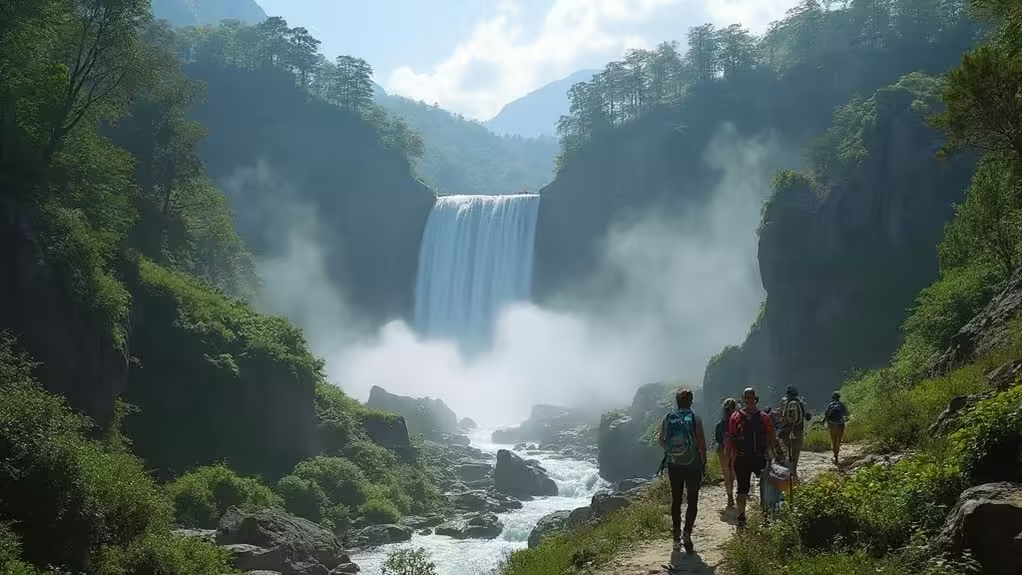
While the allure of West Coast waterfalls is undeniable, it's vital to prioritize safety during your visits. As you set out on your waterfall trail journey, remember to stay on marked paths and steer clear of slippery rocks. Wearing appropriate footwear with good traction is essential for navigating wet and uneven terrain safely. Keep a safe distance from fast-moving water and cliff edges, as strong currents and slick surfaces can lead to accidents.
To guarantee your freedom to navigate safely, follow these key safety precautions:
- Always check weather forecasts before your trip, as sudden rains can dramatically increase water flow
- Bring a whistle or signaling device in case of emergencies
- Stay alert and aware of your surroundings, especially in areas with high moisture from cascading water
Be prepared for changing conditions, as seasonal variations can affect water levels and trail stability. Remember, your safety is in your hands. By taking these precautions, you'll be able to fully enjoy the breathtaking power and beauty of West Coast waterfalls without putting yourself at risk. Stay smart, stay safe, and savor the incredible natural wonders awaiting you.
Lesser-Known Gems Worth Discovering
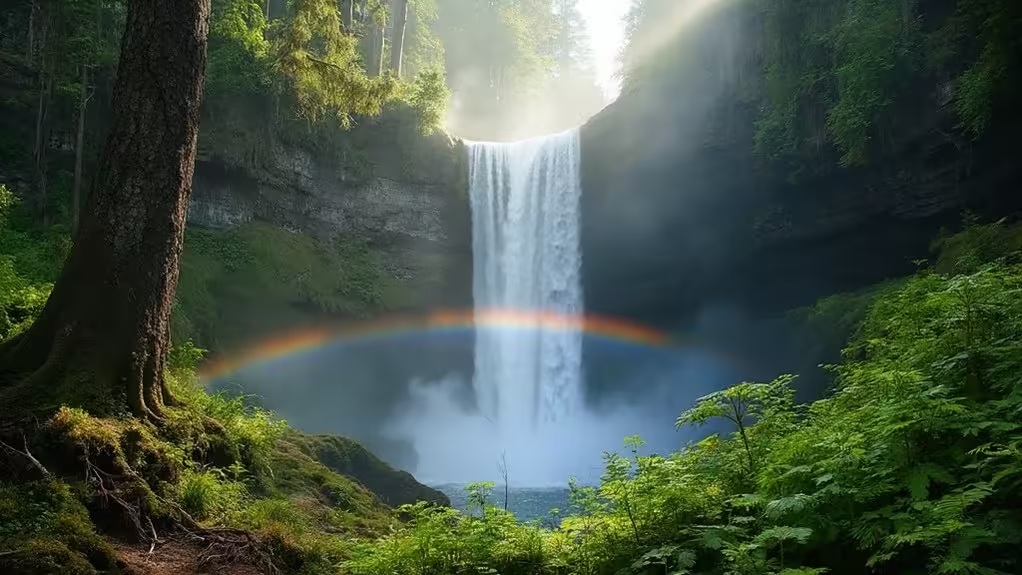
While famous waterfalls often steal the spotlight, you'll find some incredible hidden gems tucked away in the Pacific Northwest and California. In Oregon's lush forests, lesser-known cascades tumble down mossy cliffs, offering serene experiences for those willing to investigate off the beaten path. California's rugged terrains hide secret plunges that reward adventurous hikers with pristine pools and breathtaking views, far from the crowds of more popular destinations.
Hidden Pacific Northwest Cascades
Nature enthusiasts and waterfall chasers will find a wealth of hidden cascades in the Pacific Northwest. You'll uncover breathtaking sights like Loowit Falls, a stunning 186-foot drop straight from Mount St. Helens' volcanic crater. For an easily accessible gem, head to Olympic National Park's Marymere Falls, where a scenic 90-foot cascade awaits just off a busy highway.
If you're up for an expedition, don't miss these hidden wonders:
- Vincent Creek Falls: A dramatic 250-foot plunge visible from High Steel Bridge
- Kennedy Creek Falls: A two-tiered beauty requiring a half-day hike along a closed logging road
- Hamma Hamma Falls: A roaring cascade accessible via a high concrete bridge
These lesser-known waterfalls offer a chance to escape the crowds and immerse yourself in nature's raw power. You'll feel the spray on your face as you stand in awe of Vincent Creek Falls' impressive drop or listen to the thunderous roar of Hamma Hamma Falls. Whether you're seeking a quick snapshot or a challenging hike, the Pacific Northwest's hidden cascades promise unforgettable experiences for those willing to venture off the beaten path.
Undiscovered California Plunges
California's lesser-known waterfalls offer a rich collection of hidden gems for adventurous seekers, showcasing breathtaking scenery and unique geological formations. For those interested in investigating even more hidden wonders, check out hidden waterfall hikes across the state. If you're craving a challenge, Cedar Creek Falls in Ramona won't disappoint. This impressive cascade drops 80 to 90 feet into a stunning pool, but you'll need to conquer a strenuous 6.6-mile hike to reach it. For a truly unique experience, head to Point Reyes National Seashore and uncover Alamere Falls, a rare tidefall that plunges 40 feet directly into the ocean. Winter and spring rains make it an unforgettable sight.
Near Jenner, you'll find Stump Beach Falls, a 30-foot cascade that's best viewed after heavy rainfall. A short hike from Stump Beach leads you to this hidden treasure. For a peaceful retreat, investigate Carson Falls in the Mount Tamalpais Watershed. This multi-tiered waterfall is just a half-mile hike from the Little Carson Trail, offering serene views and a chance to escape the crowds. While not in California, nearby Loowit Falls on Mount St. Helens presents an otherworldly terrain for those willing to venture further afield.
Ecological Impact of Seasonal Waterfalls

Seasonal waterfalls' ecological impact extends far beyond their visual appeal. These natural wonders play a vital role in shaping and sustaining the diverse ecosystems around them. As you investigate the West Coast's powerful seasonal falls, you'll witness nature's ingenious system of nutrient flow and biodiversity in action.
Here's how these waterfalls contribute to their surroundings:
- They facilitate nutrient transport, supporting various plant and animal species
- Snowmelt-fed falls increase streamflow, maintaining aquatic habitats
- Fluctuating water volumes influence sediment movement, affecting riverbank stability
You'll be amazed at how these falls create unique microhabitats, providing essential resources for species adapted to changing environments. Amphibians and certain fish thrive in these lively settings, showcasing nature's resilience.
However, your freedom to investigate comes with responsibility. Increased visitation during peak flow seasons can pressure these fragile ecosystems. It's up to you to help protect these natural wonders. By supporting conservation efforts and treading lightly, you'll guarantee that future generations can experience the awe-inspiring power and ecological importance of seasonal waterfalls. Remember, your actions today shape the environments of tomorrow.
Best Viewing Spots and Overlooks
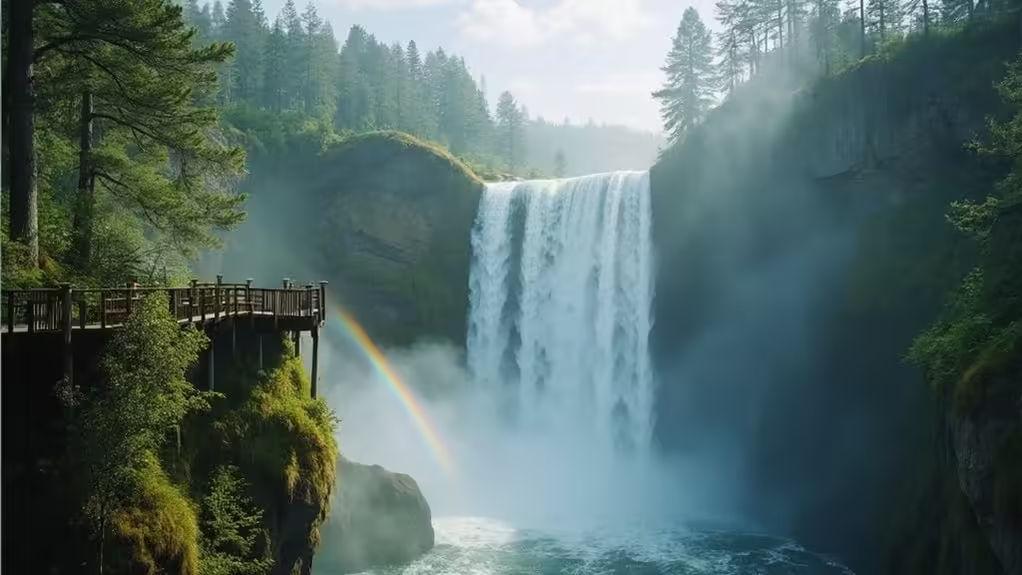
Adventurers seeking the best views of West Coast seasonal waterfalls won't be disappointed. You'll find iconic spots that showcase nature's raw power and beauty. At Yosemite Falls, you can witness the cascading water from the base or the Mist Trail's viewing platform. For a unique experience, head to McWay Falls in Big Sur, where you'll see water plunging directly onto the beach from an overlook off Highway 1.
If you're up for a close encounter, Multnomah Falls in Oregon offers a scenic bridge that'll put you right in the mist. For those who enjoy a challenge, the 6.6-mile hike to Cedar Creek Falls rewards you with an impressive 80- to 90-foot waterfall at the end. Don't miss Snoqualmie Falls in Washington, where you can capture stunning photos from the observation deck year-round.
| Waterfall | Best Viewing Spot | Peak Season |
|---|---|---|
| Yosemite Falls | Mist Trail platform | Spring |
| McWay Falls | Highway 1 overlook | Year-round |
| Multnomah Falls | Scenic bridge | Spring |
These viewpoints offer unforgettable experiences, allowing you to engage with nature's untamed beauty and feel the freedom of the great outdoors.
Frequently Asked Questions
What Is the Second Most Powerful Waterfall in the United States?
You'll be amazed by Snoqualmie Falls, the second most powerful waterfall in the US. It's a 270-foot drop of pure, unbridled force. You've got to witness its 54,000 gallons per minute rush to truly appreciate its might.
What Is the Most Powerful Waterfall in Oregon?
You'll find Oregon's most powerful waterfall at Multnomah Falls. It's a breathtaking 620-foot cascade that'll leave you in awe. Don't miss the chance to experience its raw power and beauty firsthand. It's truly unforgettable!
What Is the Most Powerful Waterfall in the World?
You might think Niagara or Victoria Falls are the most powerful, but they're not. The world's mightiest waterfall is Inga Falls in the Congo. It's a beast, releasing a staggering 910,000 cubic feet of water per second.
What Is the Highest Year Round Waterfall in the United States?
You'll find the highest year-round waterfall in the U.S. at Yosemite National Park. It's called Ribbon Falls, and it's a breathtaking 1,612-foot drop. You're free to hike up and witness its unrestrained power firsthand.

